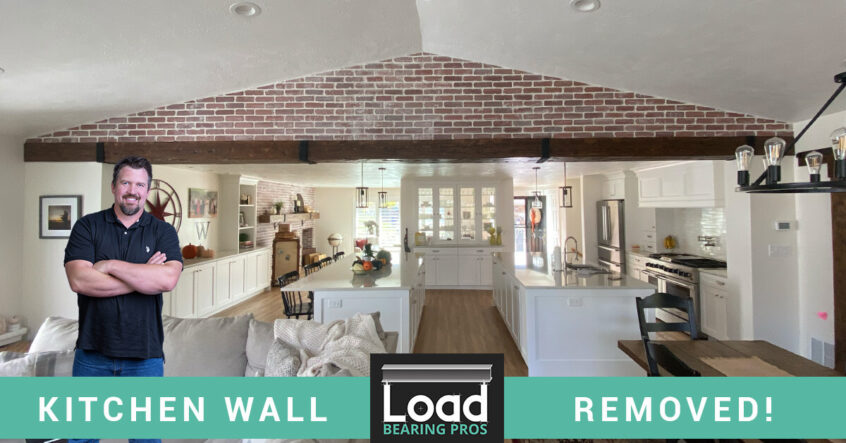If you’re a homeowner looking to upgrade your house’s usability and appeal, without breaking the bank, you may want to consider modifying its internal layout. This can be done by knocking down an interior wall and creating an open space. It’s an effective way to allow natural light and fresh air into your home while also improving the visibility of other rooms.
Sometimes, this may mean taking down a load bearing wall, which supports the weight of your house and keeps it standing. Tearing down such a wall is a tricky proposition that requires proper knowledge and experience.
Load bearing wall removal is, without a doubt, a job best left to professionals.
However, you can’t hire the first contractor you meet. You need to ensure the specialist you work with is capable of handling the entire scope of your project. The best way to do this is to ask them the right questions.
Getting answers to questions related to taking down a load bearing wall from an actual load bearing wall removal specialist will make sure everything goes as planned. In this post, we will discuss some of the key questions to ask them.
1. Is There an Alternative to Wall Removal?
Load bearing wall removal is a huge endeavor, so you should be clear about one thing: if removing the entire wall is absolutely necessary.
To get your answer, ask the load bearing wall removal specialist about the cost, time, and effort that will go into the job, then weigh the answers against the benefits you stand to gain.
If you want to remodel your home, and the wall is the only thing preventing you from doing so, then removing it will probably pay off in the long term. However, if there is an alternative to removing the wall, you should give it some thought.
A certified load bearing wall removal specialist will be able to guide you appropriately and should help you decide if the removal is worthwhile. With their inputs, you will be able to make an educated, financially savvy decision.
2. How Do You Know If the Wall Is a Load Bearing One?
Before taking down the wall, your wall removal professional should confirm that it is actually load bearing. If they say that it is, don’t just take their word for it – ask how they came to that conclusion.
Some walls in your home are built with the sole purpose of separating the rooms, while others are put in place to support your house. How does your load bearing wall removal specialist decipher which wall has been erected for what purpose?
They will probably check the original plans or blueprints of your house to identify the load bearing walls. Alternatively, they may inspect certain walls by checking if they’re connected to joists in the attic. These kinds of steps help them understand your house and make the right decision.
3. Do You Have the Necessary Permits?
Depending on where you live, you might need to procure permits before making any structural changes to your home. Most municipalities consider load bearing wall removal to be a structural change, so it is highly likely that a permit will be needed.
Find out if your load bearing wall removal specialist already has or can obtain the necessary permits in time.
It can be extremely risky to engage with contractors who work without the mandatory paperwork – it might cause legal trouble down the road. Furthermore, the lack of permits can slow down your project and cost you more in the long term.
4. Will Redirecting the Wall’s Pipes and Wires Take a Long Time?
Once your load bearing wall removal specialist has identified the wall to be removed, they should check if it contains any plumbing/gas pipes, ducts or electrical wiring. If it does, these pieces will need to be rerouted safely before the wall is taken down.
Sometimes, determining the location of pipes and wires can be complex. Shifting your pipes and wiring can increase your expenses and increase the duration of the project. That’s why it’s also important to the project completion timeline before the work begins.
5. How Do You Add Support Structures?
The primary purpose of a load bearing wall is to support your home’s ceiling and transfer the weight down to the foundation. Removing a wall that is helping your home stand firmly will mean installing additional structural support in its place. Ask your load bearing wall removal specialist about this..
Most commonly, a support beam is installed under the ceiling of the home before removing a load bearing wall. The beam needs to be supported from each end so the weight can be distributed to the home’s foundation. Your wall removal professionals should be able to advise you on how this can be done in your house.
6. Will the Wall Removal Affect the Flooring?
Apart from the structural concerns of removing a load bearing wall, you may want to know about the aesthetic implications of this move. Removing a wall will leave an empty space on the floor where the wall used to stand. Some amount of replastering may also be needed on the adjoining walls.
Ask the load bearing wall removal specialist if they provide flooring solutions that may be required after the wall removal is completed. Remember: replacing hardwood, vinyl or carpets will cost you more and may call for the services of different professionals.
7. How Will My Living Space Change?
Removing load bearing walls helps homeowners create a space for a more open feel and increased usability. With the rising demand for open-floor layouts in residences, removing a load bearing wall can even increase the resale value of your home.
That being said, you should discuss this with your load bearing wall removal specialist. How will bringing down the wall affect the lighting in your home? Will the airflow be impacted? Will you need to take down other walls to balance the look of your home’s interior?
You might also want to rope in an interior decorator to help you better visualize your new space.
8. How Do You Deal with Hazardous Materials?
Removing a wall can leave your home covered in dust and debris, which pose a potential health hazard. If your home was built before the 1980s, asbestos was likely used in the construction – and it might still be present in your walls. Lead paint is another potential hazard that may be secretly hiding in your home.
Taking down a load bearing wall can release asbestos fibers and other toxins into the air, which may harm not only you, but also the workers in your house.
The wall removal contractor you work with should know how to test the walls for asbestos and lead paint. They should also know about the steps involved in controlling/minimizing exposure to these harmful materials.
For safety purposes, you should consult experienced load bearing wall removal specialists before proceeding with any wall removal activity in your home.
In Conclusion
Load bearing wall removal is a big project – it has a direct impact on the structural integrity of your house. Taking down such a wall is different from removing a non-loading bearing wall, and the process requires the right skills and tools.
Whether you’re planning a kitchen load bearing wall removal or a project in another room, you should always hire a specific load bearing wall removal specialist. Ensuring that you’re working with the right one is crucial. Ask the above-mentioned questions to gauge the professional’s experience and abilities. Furthermore, check whether or not they have the right tools, technology, and documentation to perform the job with safety and reliability.
Still on the hunt for professionals you can trust?
Load Bearing Pros are experts at handling load bearing wall removal projects. We know how to deliver the goods in a quick and safe manner. Call us at (385) 300-8322 to talk to a wall removal expert or fill out our online form to receive a free project bid.

